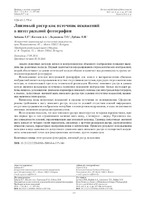| dc.contributor.author | Зайцева, Е. Г. | |
| dc.contributor.author | Кислюк, А. А. | |
| dc.contributor.author | Ларионова, Т. О. | |
| dc.contributor.author | Дубина, Н. Н. | |
| dc.coverage.spatial | Минск | ru |
| dc.date.accessioned | 2019-01-03T05:36:51Z | |
| dc.date.available | 2019-01-03T05:36:51Z | |
| dc.date.issued | 2018 | |
| dc.identifier.citation | Линзовый растр как источник искажений в интегральной фотографии = Lens Raster as a Source of Distortions in Integral Photography / Е. Г. Зайцева [и др.] // Приборы и методы измерений : научно-технический журнал. – 2018. – Т. 9, № 4. – С. 337-346. | ru |
| dc.identifier.uri | https://rep.bntu.by/handle/data/48427 | |
| dc.description.abstract | Анализ известных методов записи и воспроизведения объемного изображения позволяет выделить два различных подхода. Первый заключается в формировании стереоскопических изображений, второй обеспечивает создание оптической модели объекта и включает как разновидность группу методов интегральной фотографии.
Использование методов интегральной фотографии для записи и воспроизведения объемных изображений является актуальным вследствие отсутствия недостатков, присущих стереоскопическим методам, и относительной простоты технической реализации. Наличие линзового растра в данном методе является возможным источником появления искажений изображения. Целью настоящей работы являлось установление диапазона параметров линзовой системы для интегральной фотографии, а именно, допустимых значений шага линзового растра при условии отсутствия искажений, вызванных наличием этого растра. Приведены виды возможных искажений и указаны источники их возникновения. Сформулированы требования к шагу линзового растра, исходя из условий отсутствия ложной информации, отсутствия прерывности изображения по глубине и в поперечном направлении, а также незаметности
линзовых элементов матрицы воспроизведения. Исследования показали, что шаг линзового растра лимитируется четырьмя неравенствами, причем первые три из них ограничивают значение шага снизу, а четвертое – сверху. Произведен анализ совокупности условий, ограничивающих шаг линзовой матрицы. Границы допустимых значений
шага зависят от четырех групп параметров, связанных с другими размерами растра, расположением объектов съемки, параметрами воспроизведения и наблюдения. Приведен результат использования методики в виде зависимости допустимого диапазона шага линзового растра от поперечной координаты записываемой точки при фиксированных значениях других параметров. | ru |
| dc.language.iso | ru | ru |
| dc.publisher | БНТУ | ru |
| dc.title | Линзовый растр как источник искажений в интегральной фотографии | ru |
| dc.title.alternative | Lens Raster as a Source of Distortions in Integral Photography | ru |
| dc.type | Article | ru |
| dc.identifier.doi | 10.21122/2220-9506-2018-9-4-337-346 | |
| local.description.annotation | Analysis of methods for recording and reproducing a three-dimensional image allows to distinguish two different approaches. The first approach consists in formation of stereoscopic images, the second one provides the formation of an optical object model and includes particularly a group of integral photography methods. The use of integral photography methods for recording and reproducing volumetric images is relevant due to the lack of flaws inherent for stereoscopic methods and relative simplicity of technical implementation. Lens raster used in this method is a possible source of image distortion. This paper aim is to determine the range of parameters of the lens system, namely, the allowable values
of the pitch of the lens raster, providing distortions absence caused this raster. Types of possible distortions and sources of their occurrence are indicated. The requirements for the pitch of the lenticular raster are formulated, based on conditions of false information absence, absence of discontinuity of the image in depth and in the transverse direction, and invisibility of lens elements of the reproduction matrix. Studies shoed that the lenticular pitch is limited by the four inequalities, three of which limit the pitch value from below, and the fourth one from above. A set of conditions limiting the step of the lens matrix was analyzed. The boundaries of allowable step values depend on four groups of parameters: raster dimensions, location of the subjects, reproduction and observation parameters. Result of the method usage as a dependence of the allowable range of the pitch of the lenticular raster on transverse coordinate of the recorded point with fixed values of other parameters is p resented. | ru |

